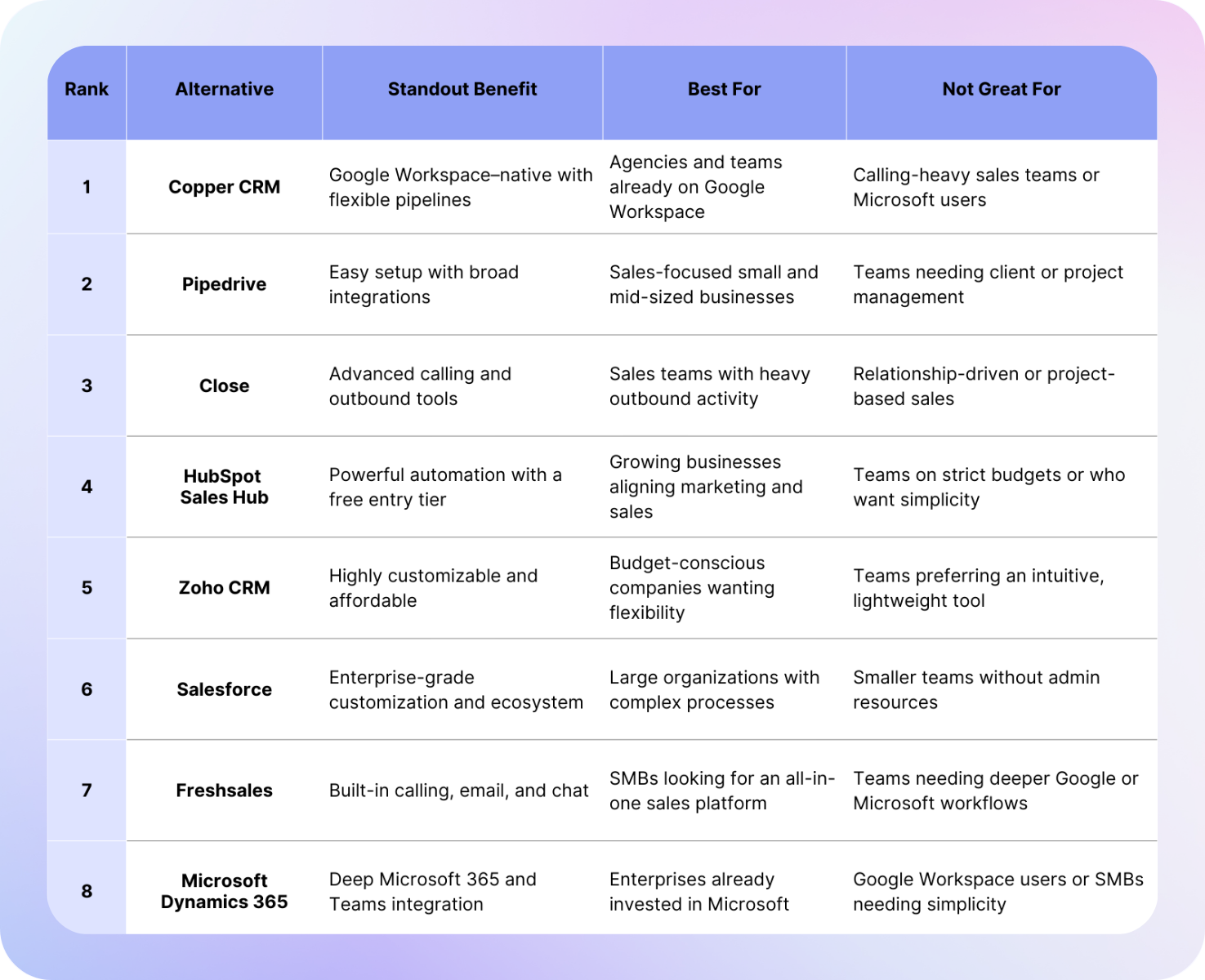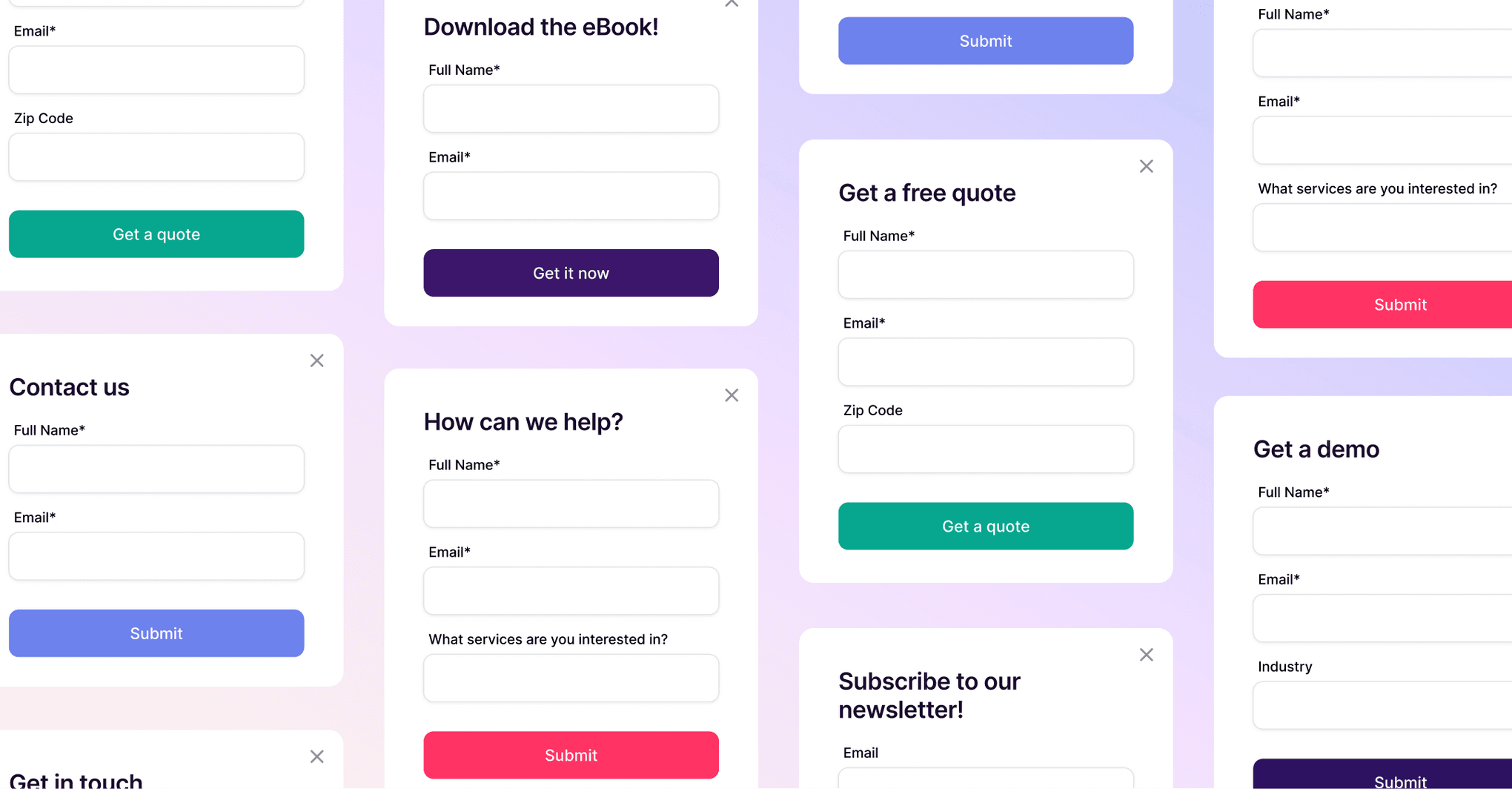Jessica Andrews
VP Marketing
Key Takeaways
Zendesk announced that Zendesk Sell CRM will officially sunset in August 2027, requiring current users to migrate to alternative CRM platforms before the retirement date.
Copper CRM offers the strongest Google Workspace integration with native Gmail functionality and includes a Zendesk integration that displays support ticket details directly within the CRM interface.
Close CRM provides built-in calling, SMS, and email capabilities with power dialer features, making it the top choice for outbound sales teams that rely heavily on phone-based prospecting.
HubSpot Sales Hub delivers robust automation features and a generous free tier, though pricing escalates quickly as teams add users and unlock advanced functionality.
If you’re currently using Zendesk Sell (formerly Base CRM), you know it earned its reputation as an “easy-to-use” customer relationship management (CRM) system for small businesses that wanted a straightforward way to track deals.
When Zendesk acquired Base in 2018, the company promised a bold vision: to merge Zendesk Sell and Zendesk Support into a single, unified customer management platform. For many users, that seemed like the perfect way to connect sales and support teams under one roof.
But that vision never fully materialized.
Despite years of effort, Sell and Support stayed in their own silos. Instead of working from one clean system, customers ended up bouncing between two different worlds, never quite getting that promised “single source of truth.”
Fast-forward, and Zendesk has now announced that Sell will officially sunset, effective August 2027.
That may feel far off, but for businesses that depend on Sell, the clock is ticking — it’s time to start planning for a CRM that’s built to stick around and actually grow with you.
Here’s the good news: the CRM landscape today is more competitive (and exciting) than ever.
You’ve got options: whether you want a system that works seamlessly inside Google Workspace, a platform that’s built for serious outbound sales, or an enterprise-grade tool with all the bells and whistles like marketing automation and advanced reporting.
Whatever your business needs, there’s a replacement out there that won’t just match what you had with Sell — it’ll likely exceed it.
In this guide, we’ll break down the five best Zendesk Sell alternatives worth considering. Each one brings a unique strength to the table, so you can choose the CRM that best fits your team’s workflows and future goals.
1. Copper CRM — Best choice for Google Workspace users
If your team lives in Gmail, Google Calendar, and Drive, Copper is a no-brainer.
Most CRMs say they integrate with Google Workspace. Copper was actually built inside it. That means you can add leads, track opportunities, and log activities without ever leaving your inbox. No clunky connectors. No double-keying the same info. Just a CRM that feels like part of the Google tools you already use every day.
Now, one of the biggest anxieties Zendesk Sell users share? Losing visibility into what the support team is saying to customers.
Copper solves this with a native Zendesk integration that surfaces ticket details right inside the CRM. Sales teams can see open and past support cases linked to a contact or account without ever leaving Copper, which encourages team collaboration and ensures that customer conversations don’t fall through the cracks.
And it doesn’t stop there. Copper’s flexible pipelines let you run both sales and project workflows in one place (because who wants to juggle multiple systems?). Automations keep reps on top of follow-ups without the mental gymnastics, while dashboards and reporting give leadership a clear view of performance.
In short: it’s built to keep your team moving forward, not chasing down details.
Pros: Deep Google Workspace integration, Zendesk support ticket integration, flexible pipelines, intuitive interface, iPhone and Android mobile app, LinkedIn integration
Cons: Only supports Google Workspace (No Microsoft 365!), doesn’t include native calling tools (you’ll need JustCall or RingCentral), does not support mass outbound email.
If your team isn’t on Google Workspace, here’s a few more alternatives to try!
Copper CRM's Drag and Drop Pipelines
2. Pipedrive — Great for migration flexibility
Pipedrive is another solid option, especially for teams that want a CRM that keeps things simple and sales-focused. Its visual pipelines are a fan favorite and make it easy to see exactly where deals stand at a glance.
One big plus: Pipedrive is an official migration partner for Zendesk Sell.
Translation? They’ve put real effort into making the switch painless, which is a huge relief if your team’s already stressing about data transfers and setup.
Add in their marketplace of 450+ integrations, and you’ve got a CRM that can slot into almost any sales stack without much fuss.
But here’s the tradeoff: Pipedrive is laser-focused on sales. That’s great if closing deals is your only priority, but it also means you won’t get project tracking or the deeper Google Workspace magic you’d find with Copper. So if your team needs a CRM that can carry you from first pitch all the way through post-sale workflows, Pipedrive might leave you wanting more.
Pros: Easy-to-use interface, strong visual sales pipelines, powerful lead management, official Zendesk migration support, large integration library.
Cons: Sales-only focus, lacks project management features, limited native automation compared to larger CRMs, does not support phone calls.
Pipedrive's Pipelines feature
3. Close — Calling and outbound sales powerhouse
If your team loved Zendesk Sell for its built-in calling tools, then Close may be your best bet.
Close was designed with inside sales teams in mind, and it comes with calling, SMS, multi-channel and email all baked into the platform. This gets rid of the need for third-party telephony tools and keeps everything in one place.
Close also includes productivity features like power dialer functionality and predictive dialer, helping reps make more calls in less time. Combine that with email sequences and activity tracking, and it’s a strong choice for omni-channel teams, or outbound-heavy sales teams that live on the phone.
Where Close can fall short is for teams that need more flexible pipelines or project management features. It’s highly effective for prospecting and outbound, but not always as strong for relationship-based selling or managing client delivery after a deal closes.
Pros: Built-in calling, SMS, and email; power dialer features; great for outbound sales teams.
Cons: Less suited for post-sale or project-driven teams.
Close.io Pipelines list
4. HubSpot Sales Hub — Automation-rich with a generous free tier
HubSpot has long been known for its marketing automation, but its Sales Hub has grown into one of the most popular CRMs on the market. One reason is its free tier, which makes it easy for small teams to start experimenting with CRM features before having to upgrade to paid plans.
But the real power of HubSpot CRM lies in its automation and scalability.
With HubSpot, sales teams can offload a lot of the repetitive stuff—lead assignment, follow-up emails, deal creation, dashboards, reporting — so reps spend less time clicking boxes and more time closing deals.
And if you’re already using HubSpot’s Marketing Hub, adding Sales Hub feels like leveling up. Marketing and sales finally share one smooth system, which means leads don’t just get handed over.
The trade-off is cost. As your team grows and you unlock more advanced features, HubSpot pricing can scale quickly. Some companies find themselves paying significantly more than they originally planned as they add users or features.
Pros: Robust automation, free entry-level CRM, seamless marketing and sales alignment, scalable.
Cons: Pricing escalates quickly, advanced features may require expensive upgrades.
HubSpot CRM
5. Zoho CRM — Flexible and budget-friendly
While Zoho CRM is overlooked, it delivers impressive value. Zoho is highly customizable, allowing you to tailor pipelines, dashboards, and workflows to match your business processes.
It also includes an AI assistant called Zia, which can give recommendations and predictions to help guide sales teams.
Perhaps the biggest draw is pricing. Zoho is one of the cost-effective CRMs on the market, making it attractive for small businesses or those with tighter budgets. At the same time, its feature set is broad enough to compete with much more expensive platforms.
The downside, thought, is that Zoho can feel more complex to set up and use. While it offers a lot of flexibility, the interface isn’t as polished as tools like Copper or Pipedrive, and it may require more administrative effort to configure properly.
Pros: Affordable, highly customizable, AI-powered insights, broad feature set.
Cons: Steeper learning curve, less intuitive interface, setup can be time-intensive.
Zoho CRM Dashboards
6. Salesforce — Enterprise-grade powerhouse
No list of CRM alternatives would be complete without Salesforce, the global leader in CRM.
Salesforce offers virtually unlimited customization, from custom objects to advanced workflow automation, AI-powered forecasting, and integrations with thousands of apps. For organizations with complex sales processes, Salesforce provides the flexibility and scale needed to handle growth.
That said, Salesforce can be overwhelming for smaller teams. You'll often need dedicated admins to configure and maintain it. The cost is also high compared to other CRMs on this list.
Pros: Enterprise-level customization, powerful automation, extensive ecosystem.
Cons: Expensive, steep learning curve, often requires dedicated admin support.
Salesforce CRM account records
7. Freshsales — All-in-one sales engagement
Freshsales is a strong pick if you’re looking for a true all-in-one hub. It bundles core CRM features with built-in calling, email, and chat, so sales teams can manage conversations without having to jump between tools.
On top of that, its AI-driven lead scoring and deal insights help reps zero in on the opportunities that actually matter. And compared to heavyweight systems like Salesforce, Freshsales tends to be far easier to roll out and get your team using quickly — which is no small win when adoption is half the battle.
Freshsales may not have the same level of ecosystem depth as HubSpot or Salesforce, but for growing SMBs, it strikes a great balance of functionality and affordability.
Pros: Built-in communication tools, AI insights, affordable pricing.
Cons: Less extensive integration ecosystem, weaker at project workflows.
Freshsales Pipelines
8. Microsoft Dynamics 365 — Best for Microsoft ecosystem users
For businesses that run on Microsoft 365 rather than Google Workspace, Dynamics 365 is worth considering. It integrates tightly with Outlook, Teams, and the larger Microsoft ecosystem, making it attractive for enterprise companies already invested in Microsoft software.
Dynamics 365 offers advanced sales forecasting, AI insights, and customization options similar to Salesforce, but with native Microsoft connections. However, it’s often seen as complex and more enterprise-focused than SMB-friendly.
Pros: Deep Microsoft 365 integration, robust customization, AI and forecasting.
Cons: Complexity, enterprise pricing, less intuitive than Google-focused CRMs.
Microsoft 365 Dynamics reports
CRM alternatives at a glance

Final Thoughts
At the end of the day, the “right” CRM depends on how your team works and where you want to go next. Each platform has its strengths, and the best fit comes down to your priorities:
-
If you’re a Google Workspace team → Copper is the best fit with native integration and Zendesk ticket visibility. You can even try it free for 14 days to see how seamlessly it fits into your day-to-day.
-
For sales-driven teams that want quick migration → Pipedrive offers clarity and ease.
-
If calling is your core → Close or Freshsales will feel familiar.
-
If you want to scale with automation → HubSpot or Salesforce are excellent bets.
-
If you’re budget-conscious or a Microsoft shop → Zoho or Dynamics 365 could be the right move.
No matter which path you take, the goal isn’t just replacing Zendesk Sell, it’s choosing a CRM that will grow with your team, support your workflows, and set you up for the long term.






